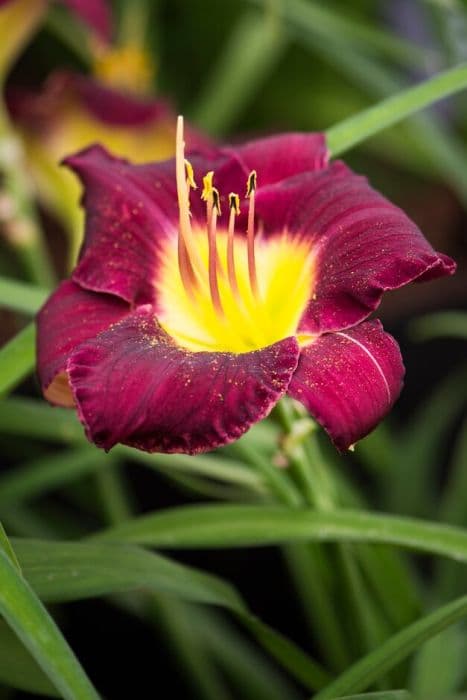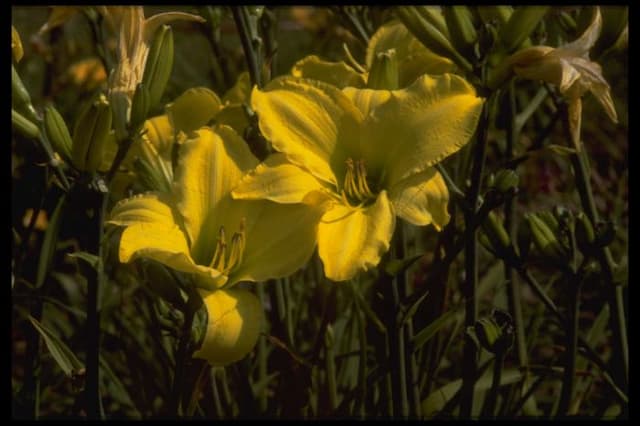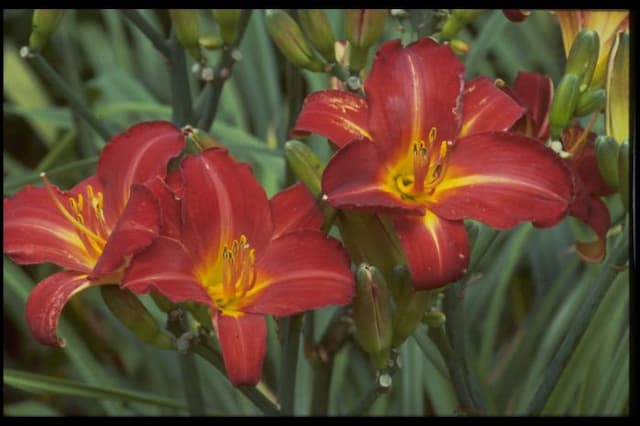Daylily Hemerocallis 'Pinhill Navajo Beauty'

ABOUT
The Hemerocallis 'Pinhill Navajo Beauty', commonly known as a Daylily, is a striking perennial plant known for its vibrant, showy flowers. The blossoms exhibit a rich blend of colors, typically featuring a warm, creamy yellow base with a pronounced eye of deep plum to maroon shades, giving the flower a stunning two-toned effect. This eye-catching contrast is further accented by a subtle blush of pink, spreading towards the gently ruffled edges of the petals. Each flower of the Daylily presents a smooth and waxy texture, exuding a fresh, lively appearance. A single Daylily plant produces multiple flowers that bloom in succession, ensuring a continuous display of color throughout the blooming period. The flowers are borne on sturdy, arching stalks, which rise gracefully above a lush mound of elongated, strap-like leaves. These leaves are a rich green in color and have a slightly arching habit, creating an attractive fountain-like effect. The foliage forms a dense clump and serves as an excellent backdrop for the vibrant blooms that appear at the tips of the stalks. The overall appearance of the Daylily 'Pinhill Navajo Beauty' is one of elegance and beauty, making it a beloved addition to any garden that seeks a touch of vivid color and a long season of blooms.
About this plant
 Names
NamesFamily
Hemerocallidaceae
Synonyms
Daylily
Common names
Hemerocallis 'Pinhill Navajo Beauty'
 Toxicity
ToxicityTo humans
The Hemerocallis 'Pinhill Navajo Beauty' is a cultivar of daylily. Daylilies are generally not considered toxic to humans and are even edible in certain parts. In fact, daylily flowers and buds are historically consumed in some cultures, often added to soups or fried. However, it's important to note that people with certain sensitivities or allergies may experience adverse reactions. Ingestion by sensitive individuals could potentially lead to mild symptoms such as nausea, vomiting, or diarrhea. As with any plant, it is wise to exercise caution and avoid consumption unless absolutely certain of its safety and edibility.
To pets
The daylily, including the Hemerocallis 'Pinhill Navajo Beauty', can be toxic to cats, and potentially dogs, although cats are more commonly affected. Consumption of any part of the plant by cats can lead to symptoms such as vomiting, lethargy, and loss of appetite. In severe cases, ingestion can result in kidney failure, which can be fatal if not treated promptly. If you suspect your pet has ingested daylily, it is crucial to seek veterinary care immediately. It is always recommended to keep daylilies and other potentially toxic plants out of reach of pets to prevent accidental ingestion.
 Characteristics
CharacteristicsLife cycle
Perennials
Foliage type
Deciduous
Color of leaves
Green
Flower color
Pink
Height
2 feet (60 cm)
Spread
2 feet (60 cm)
Plant type
Bulb
Hardiness zones
3
Native area
Asia
Benefits
 General Benefits
General Benefits- Aesthetic Appeal - 'Daylily Pinhill Navajo Beauty' offers vibrant color and unique flower shapes that enhance the beauty of gardens and landscapes.
- Low Maintenance - Daylilies are known for being easy to care for, requiring minimal attention once established in the right conditions.
- Drought Tolerance - Once established, daylilies can tolerate periods of drought, making them suitable for gardens in areas with water restrictions.
- Pest Resistance - They are generally resistant to many pests and diseases, reducing the need for chemical treatments in the garden.
- Soil Adaptability - Daylilies can thrive in a variety of soil conditions, from clay to sandy soils, making them versatile for different garden settings.
- Long Blooming Period - Daylilies provide a long season of blooms, often flowering for several weeks throughout the summer.
- Attracts Pollinators - The flowers can attract butterflies, bees, and other pollinating insects, supporting local ecosystems.
- Propagation Ease - Daylilies can be easily propagated through division, allowing gardeners to expand their gardens or share with others.
- Variety of Uses - They are suitable for planting in borders, flower beds, and as ground covers due to their clumping growth habit.
- Seasonal Interest - Some daylilies offer attractive foliage even when not in bloom, adding to their seasonal interest in the garden.
 Medical Properties
Medical PropertiesThis plant is not used for medical purposes.
 Air-purifying Qualities
Air-purifying QualitiesThis plant is not specifically known for air purifying qualities.
 Other Uses
Other Uses- Edible Flowers: The blooms of the daylily can be eaten raw in salads, fried, or used as an edible garnish for a variety of dishes.
- Natural Dye: The petals of daylilies can be used to create a natural dye for fabrics or paper.
- Bee Forage: Daylilies offer nectar and pollen for bees, supporting pollinator health and biodiversity.
- Companion Planting: Daylilies can be used in vegetable gardens to attract beneficial insects and deter pests.
- Water Filtration: When planted around ponds or water features, daylilies can help filter and clean the water by absorbing excess nutrients.
- Landscaping: With their attractive foliage and flowers, daylilies are popular choices for erosion control on slopes and banks.
- Floral Arrangements: Daylily flowers and buds can be used in floral arrangements for their unique shape and color.
- Photography Subject: The striking appearance of daylilies makes them popular subjects for nature and garden photographers.
- Artistic Inspiration: The varied colors and forms of daylily flowers can serve as inspiration for artists in their paintings and drawings.
- Wedding Decor: Daylilies are sometimes used in wedding bouquets and decorations due to their vibrant colors and robust nature.
Interesting Facts
 Feng Shui
Feng ShuiThe Daylily is not used in Feng Shui practice.
 Zodiac Sign Compitability
Zodiac Sign CompitabilityThe Daylily is not used in astrology practice.
 Plant Symbolism
Plant Symbolism- Daylily (General Symbolism): Daylilies often symbolize motherhood and fertility due to their ability to produce numerous offspring, i.e., flowers and seeds. The name Hemerocallis comes from the Greek words for "day" and "beautiful," highlighting their brief but beautiful bloom.
- Transience of Life: As the name daylily suggests (each bloom lasts for only a day), these flowers are often taken to symbolize the transient nature of life and the idea that every moment should be cherished.
- Renewal and New Opportunities: Since a new flower replaces the one that withered yesterday, daylilies can symbolize renewal and the constant presence of new opportunities or hope with each new day.
- Coquetry: In the language of flowers, daylilies can represent flirtation or a playful behavior, likely due to their vibrant colors and the way the flowers only last for a single day.
- Forgotten or Lost Memories: Similarly, because the flowers are ephemeral, daylilies can sometimes be seen as a symbol of memories or beauty that is quickly forgotten or fades away.
 Water
WaterDaylilies, including the 'Pinhill Navajo Beauty' cultivar, should be watered deeply so the entire root zone is moistened. Aim to water daylilies once a week with about one inch of water, which is equivalent to about 0.623 gallons per square foot, making sure to adjust the frequency depending on rainfall and temperature. During the active growing season in spring and summer, especially in hot and dry conditions, they may require additional water. It's crucial to avoid overhead watering to reduce the risk of foliar diseases; instead, use a soaker hose or drip irrigation. Always check the top few inches of soil before watering to ensure it's dry, as overwatering can lead to root rot.
 Light
LightDaylilies like 'Pinhill Navajo Beauty' perform best in full sun to partial shade. They should receive at least six hours of direct sunlight each day to thrive and produce abundant flowers. A spot in the garden that gets morning sunlight and some afternoon shade would be ideal to protect the blooms from the intense heat of late day sun in very hot climates.
 Temperature
TemperatureDaylilies, such as 'Pinhill Navajo Beauty', are quite tolerant of a range of temperatures but they grow best when the temperature is between 60 to 75 degrees Fahrenheit. They can survive in temperatures as low as 20 degrees Fahrenheit during dormancy, and up to around 90 degrees Fahrenheit during their growing season. However, prolonged exposure to temperatures outside of their ideal range can affect their growth and blooming.
 Pruning
PruningThe 'Pinhill Navajo Beauty' daylilies benefit from pruning to remove spent blooms and stalks, which encourages reblooming and prevents the plant from using energy to set seed. Remove dead foliage in the spring to tidy the plant and promote healthy growth. Pruning is often done after the first wave of flowering, typically by mid to late summer, depending on the climate.
 Cleaning
CleaningAs needed
 Soil
SoilDaylily 'Pinhill Navajo Beauty' thrives in well-draining soil rich in organic matter with a pH of 6.0 to 6.8. For best results, a mix of two parts loam, one part peat moss, and one part perlite or sand is recommended to ensure good drainage and fertility.
 Repotting
RepottingDaylilies, such as 'Pinhill Navajo Beauty,' do not need frequent repotting and may never need it if they are in the ground. They can be divided every 3 to 5 years to control growth and rejuvenate the plant.
 Humidity & Misting
Humidity & MistingDaylilies like 'Pinhill Navajo Beauty' are generally tolerant of a variety of humidity levels and do best in typical outdoor ambient conditions, without the need for specialized humidity control.
 Suitable locations
Suitable locationsIndoor
Place 'Pinhill Navajo Beauty' in bright, indirect light indoors.
Outdoor
Plant 'Pinhill Navajo Beauty' in well-drained soil in full sun.
Hardiness zone
3-9 USDA
 Life cycle
Life cycleThe life cycle of the Daylily 'Pinhill Navajo Beauty' begins with the germination of seeds or the growth of young plants from divisions of the parent plant. After planting, the roots establish themselves in the soil, and foliage begins to emerge, consisting of long, strappy leaves that form a dense clump. The Daylily enters a vegetative stage where it focuses on growth and energy storage, during which it develops the strength to support the flowering process. The reproductive stage follows, typically in early-to-mid summer, when the plant produces tall scapes that bear a succession of large, colorful, trumpet-shaped flowers that usually last just one day before wilting. Following the bloom, if pollination occurs, seed pods may form which, upon maturing, release seeds that can lead to new plants. Finally, after flowering, the Daylily enters a period of senescence for the remainder of the season, with energy reserves directed back to the root system in preparation for dormancy during winter, to re-emerge the following spring.
 Propogation
PropogationPropogation time
Early Summer
The most popular method of propagating Hemerocallis 'Pinhill Navajo Beauty', commonly known as the Daylily, is by division. This is best done in the spring or early fall. To propagate by division, you should carefully dig up the clumps of daylilies, taking care not to damage the roots. Separate the clumps into smaller sections, ensuring each new division has several shoots and a portion of the root system. Replant the divisions immediately at the same depth they were originally growing, spacing them about 18 to 24 inches (45 to 61 centimeters) apart to give them room to grow. Water the new plantings thoroughly to help establish them. This simple, efficient process not only helps to propagate the plants but also invigorates older clumps that may have become less vigorous over time.









